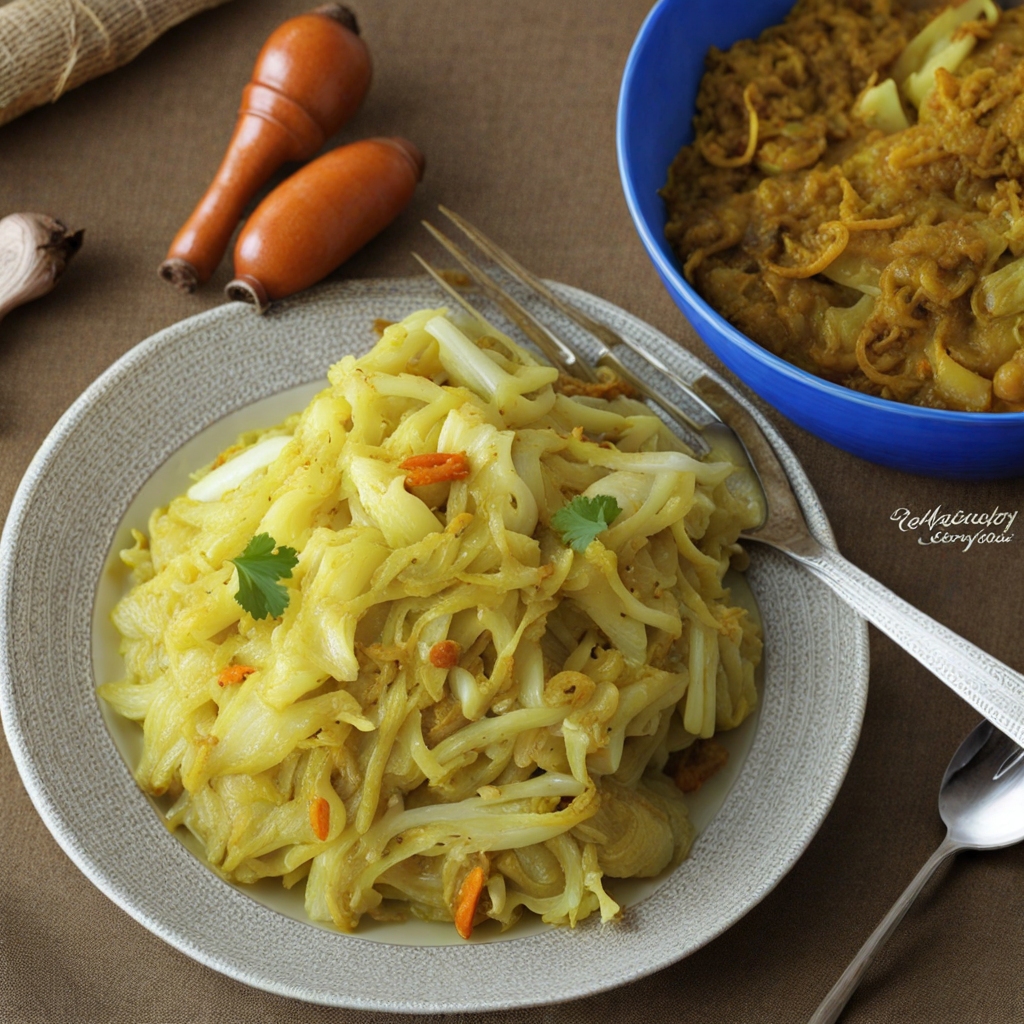Curried Cabbage
Curried Cabbage is a delightful dish that showcases the unique culinary influences of Eswatini, where traditional flavors meet vibrant spices. At its core, this dish features tender cabbage, which is sautéed until it reaches a sweet and slightly caramelized state. The cabbage is then generously coated in a fragrant blend of spices, primarily curry powder, which infuses the dish with warmth and depth. The combination of the earthy cabbage and aromatic spices creates an inviting aroma that beckons you to take a bite. As you dig into Curried Cabbage, you'll discover layers of flavor that dance on your palate. The spices not only enhance the natural sweetness of the cabbage but also introduce a hint of heat and complexity. Additional ingredients such as onions, garlic, and tomatoes may be included, adding further texture and richness to the dish. This harmonious blend of flavors makes each mouthful a satisfying experience, whether enjoyed as a main or a side dish. Curried Cabbage is not just a feast for the taste buds; it's also a celebration of the vibrant culture of Eswatini. Often served alongside traditional staples like rice or pap, it embodies the communal spirit of sharing food with family and friends. The dish is not only a perfect representation of the local cuisine but also a comforting meal that brings warmth and togetherness, making it an ideal choice for those looking to explore the rich flavors of Eswatini.
How It Became This Dish
The Culinary Journey of Likhubi: A Taste of Eswatini's Heritage #### Origins of Likhubi Likhubi, a beloved dish in Eswatini (formerly known as Swaziland), is a staple that embodies the rich cultural heritage and agricultural practices of the Swazi people. The dish primarily consists of fermented maize (corn) and is often enjoyed as a porridge or side dish. The origins of likhubi can be traced back to the pre-colonial era when maize was first introduced to southern Africa by Portuguese traders in the 16th century. The Swazi people quickly adopted maize into their agricultural practices, leading to its integration into their culinary traditions. The fermentation process involved in making likhubi not only adds a unique flavor profile but also reflects the traditional methods of food preservation practiced by many African communities. Fermentation was a necessary technique that allowed communities to extend the shelf life of their crops, ensuring food availability during lean times. Over generations, likhubi became synonymous with communal meals and gatherings, standing as a testament to the resourcefulness and adaptability of the Swazi people in their culinary practices. #### Cultural Significance Likhubi holds a special place in Swazi culture and is often associated with communal bonding. The preparation and consumption of this dish are not merely about nourishment; they represent a gathering of family and friends, showcasing hospitality and unity. Traditionally, likhubi is served during significant cultural events, including weddings, initiation ceremonies, and harvest festivals. It symbolizes abundance and is often paired with various meats, vegetables, or traditional relishes, making it a centerpiece of communal feasts. In addition to its role in celebrations, likhubi is also a comfort food. It is often prepared for those who are ill or recovering, reflecting the Swazi belief in the healing properties of traditional foods. This dish is a reminder of the connection between food, health, and community, making it an integral part of Swazi identity. #### Development Over Time As Eswatini has evolved—especially in the wake of colonialism, modernization, and globalization—the preparation and consumption of likhubi have also transformed. The introduction of new cooking methods and ingredients has impacted how this dish is made and served. In the past, likhubi was primarily prepared using natural fermentation processes that involved leaving the maize to ferment for several days. Today, while many traditional methods are still used, some modern cooks employ shortcuts or commercial yeast to speed up the fermentation process. Moreover, the increasing availability of maize flour in local markets has made it easier for families to prepare likhubi, leading to variations that cater to contemporary tastes. Some families now experiment with different types of grains, adding nutritional diversity to the dish. This adaptability showcases the resilience of Swazi cuisine, allowing it to thrive amidst changing food landscapes. Despite these changes, the essence of likhubi remains rooted in its traditional practices. The communal aspect of its preparation and consumption continues to be celebrated, with families gathering to share meals and stories, reinforcing familial bonds. In rural areas, likhubi is still prepared with great care, often cooked over an open fire, evoking nostalgia for simpler times and a connection to the land. #### Likhubi in Modern Context In recent years, likhubi has gained recognition beyond Eswatini's borders, as culinary tourism increases interest in traditional African cuisines. Chefs and food enthusiasts are exploring Swazi cuisine, showcasing likhubi in fusion dishes or in gourmet settings. This exposure has prompted a revival of interest in indigenous foods, encouraging younger generations to reconnect with their culinary heritage. Additionally, as globalization has led to a greater awareness of food sustainability and health, likhubi's fermented nature has drawn attention for its potential health benefits. Fermented foods are celebrated for their probiotic properties, which contribute to gut health, and likhubi fits seamlessly into this trend. This modern appreciation for traditional dishes underscores the importance of preserving cultural heritage while adapting to contemporary dietary preferences. Furthermore, the rise of social media has facilitated the sharing of recipes and cooking techniques, contributing to a renewed interest in likhubi among the Swazi diaspora. Many individuals living abroad are eager to recreate the tastes of their homeland, leading to an exchange of ideas and innovations that keep the tradition alive. #### Conclusion Likhubi is more than just a dish; it is a culinary emblem of Eswatini's history, culture, and communal spirit. Its origins reflect a time when resourcefulness was essential for survival, and its evolution showcases the adaptability of the Swazi people as they navigate a modern world while honoring their traditions. As likhubi continues to be enjoyed in homes and celebrated at gatherings, it remains a vital link to the past, providing nourishment for both the body and the soul. In a world that increasingly values authenticity and connection, likhubi stands proud as a symbol of the rich tapestry of Swazi culture. Whether prepared according to traditional methods or embraced in innovative ways, this dish carries forward the stories and traditions of a people, reminding us all of the power of food to unite, heal, and celebrate.
You may like
Discover local flavors from Eswatini







